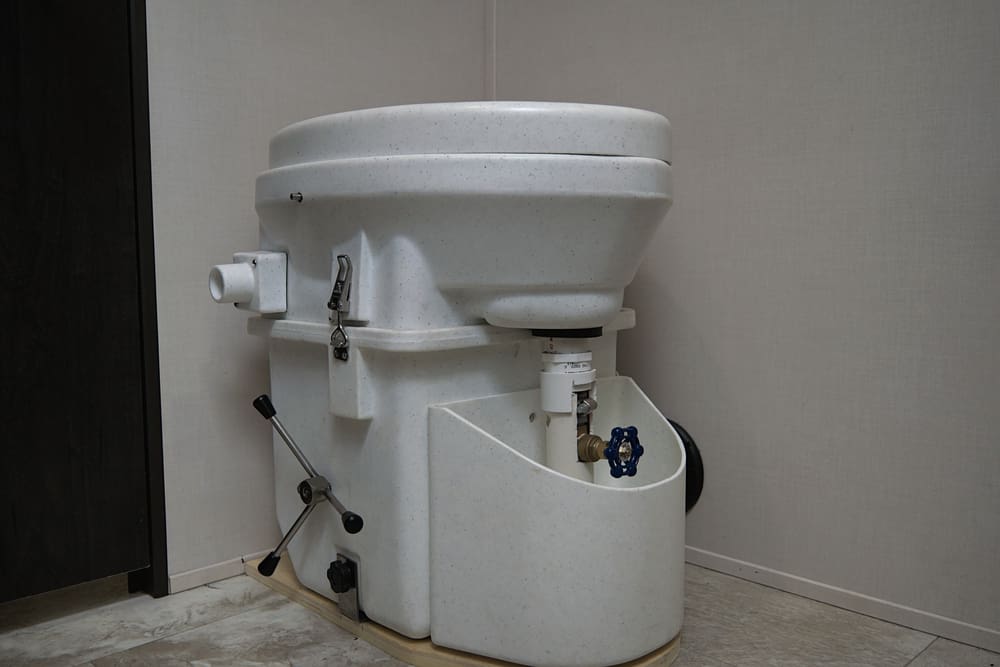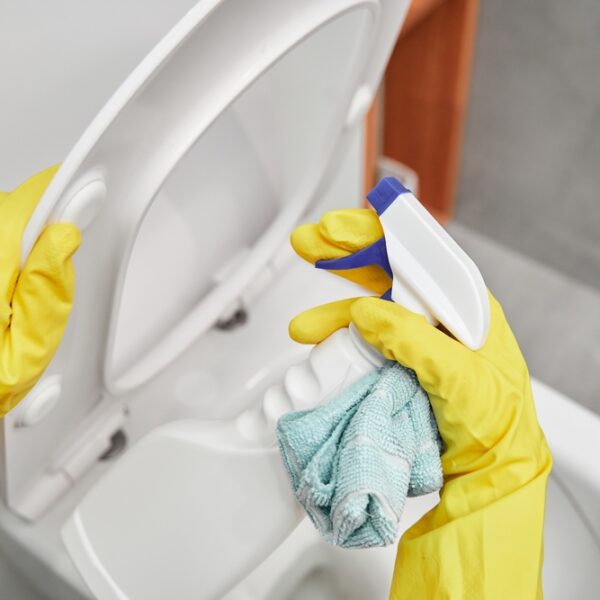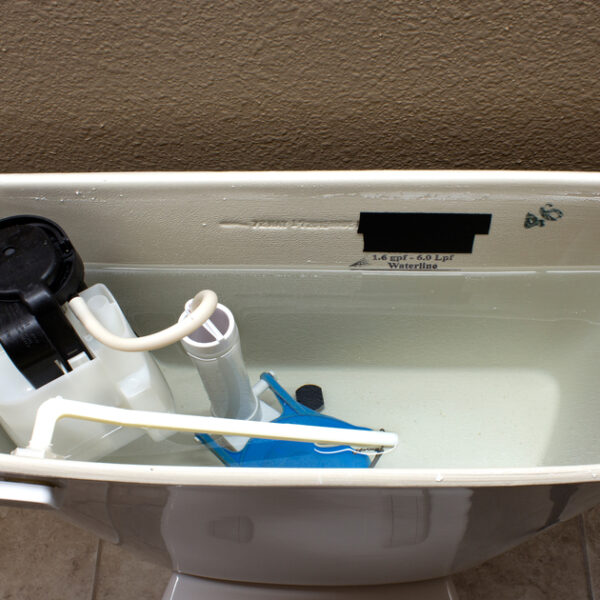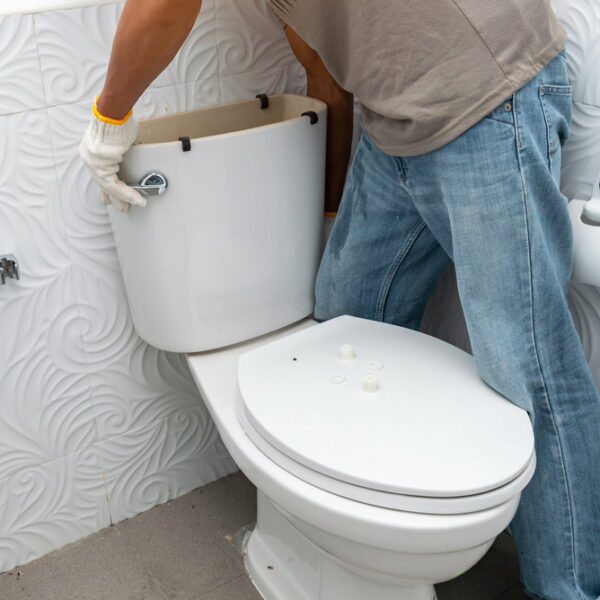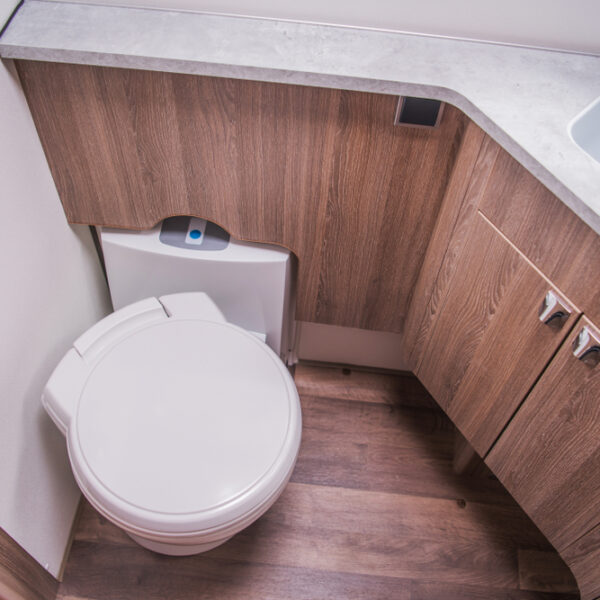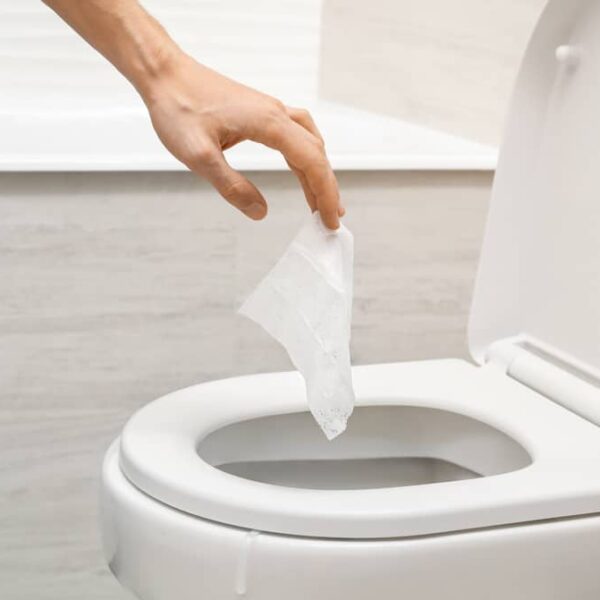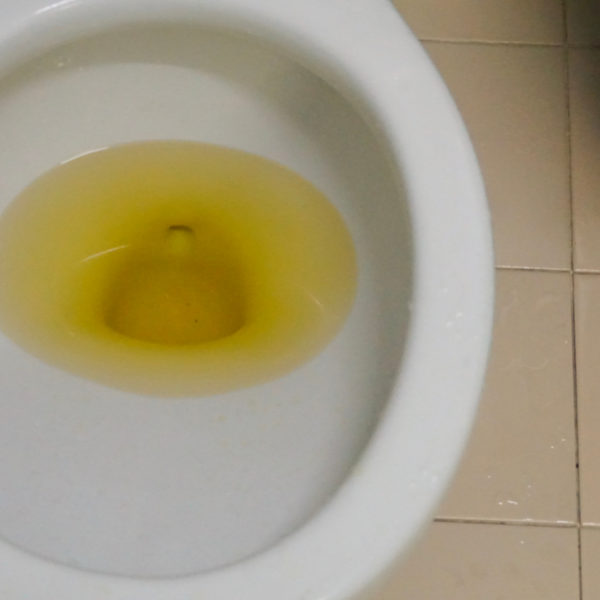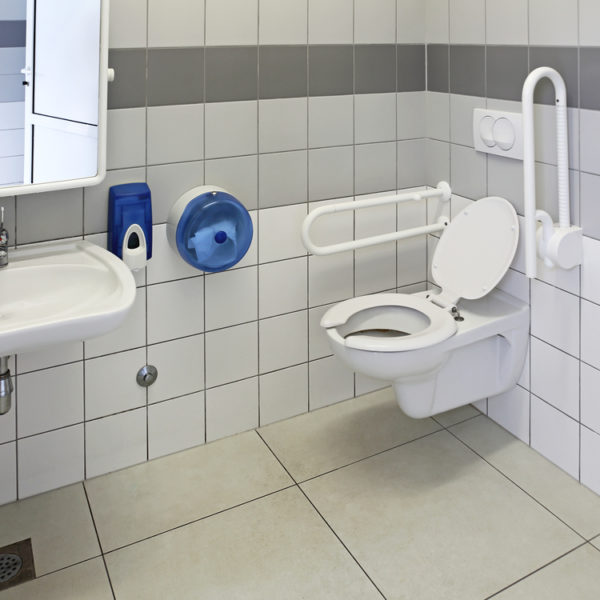If you’re thinking about joining the Tiny House movement, are considering ways to reduce your environmental footprint or simply need a toilet for somewhere that doesn’t have access to the water system, you may be considering a composting toilet.
These toilets can be a great solution since they have many advantages over regular toilets – but often, people will have several questions they need to answer before they take the plunge.
If you’re one of them, here we have all the answers you need in our extensive composting toilet FAQ.
1. What is a composting toilet?
A composting toilet is more or less what it sounds like. It’s a device that takes human waste and transforms it into hygienic compost that can then be used as fertilizer on your garden.
Otherwise, they are similar to regular toilets in many respects. They look almost like regular toilets (with the exception of the base where the waste is stored), and you use them in the same way (usually sitting down for both number ones and number twos).
One big difference is that they don’t flush, something that some people take a little time to get used to – and of course, you have to empty them from time to time since the waste isn’t washed away into the sewage system.
They are cheap to run, environmentally friendly and suitable for off-grid use, which is why they have become so popular among people living in tiny houses as well as among many others who live in more remote places without access to running water.
2. How does Composting Toilet work?
When you use a composting toilet, the human waste is kept in a storage tank where it is held while it transforms into compost. Sometimes, you can add a bulking medium to help reduce excessive moisture and smells. This also speeds up the process.
Usually, composting toilets require you to churn the contents from time to time by turning a handle – although there’s nothing dirty or unpleasant about doing this.
Once the process is complete, you then simply remove the compost and use it on your garden – or discard it as you choose.
3. What are the advantages of Composting Toilet?
Composting toilets have several clear advantages over regular toilets.
First, since you don’t need to flush them, they help save water. This makes them particularly suitable for drier areas where water conservation is important. It also means they can be used in places where a house is not connected to the mains water supply.
For this reason, they are an extremely popular option with the Tiny House community as well as with others who live off-grid.
Another advantage is that they don’t create waste – instead, they transform human excrement into compost that can be used as fertilizer. Since they don’t generate sewage, they are also a more ecological option.
Finally, they are suitable for a whole range of situations, making them an excellent alternative to conventional mobile toilets whenever a regular toilet isn’t an option.
4. Does Composting Toilet smell?
Composting toilets generally don’t smell, although sometimes you will need to add a dry medium to help soak up any odors.
Sometimes, there can be a slight odor – but this will be something more akin to the earthy smell of a regular compost pile rather than the stench associated with dirty toilets.
5. Does Composting Toilet attract flies, bugs etc.?
Composting toilets don’t tend to attract bugs or flies since they are dry and there is no odor.
That said, sometimes when organic matter is added to the waste as a bulking agent, this can introduce insect eggs to the compost, which will then go on to hatch.
Other than this, you may see the odd fly in there – but this can happen with any regular type of toilet too, so in a word, composting toilets don’t attract bugs any more than other types of toilet.
The likelihood of a fly infestation increases as the amount of time between emptying the toilet increases. If you do suffer an outbreak, simply empty the toilet, give it a good clean and start again – it shouldn’t be a huge issue, although it can be a little unpleasant if it happens.
6. Are Composting Toilets expensive?
The initial outlay for a composting toilet is likely to be higher than buying a regular toilet. As a ballpark figure, you can expect to pay in the region of $1000 for a composting toilet, although cheaper and more expensive models exist.
However, in the long run, they can help save you money on water bills since you don’t need to flush after each use, and there are few other running costs, so other than what it costs you to buy the toilet itself, they are an economical choice overall.
7. Are Composting Toilets big?
Most composting toilets are comparable to regular toilets in terms of size. This means the experience of sitting on one to use it is also comparable, and once you get used to it, you will hardly notice that you are using anything other than a “normal” toilet.
The only part that is different is the base of the toilet. They usually have a large, rectangular base as opposed to the size and shape of the pedestal of a regular toilet. This is due to the fact that the composting toilet collects your waste underneath it.
8. Are Composting Toilets expensive to operate?
Once you’ve bought a composting toilet, there are few running costs, making them cheaper to own than a regular toilet.
The only thing you might need to spend money on is a bulking agent that is used to mix with the waste to reduce moisture, aid in the composting process and reduce unpleasant odors.
Most people use things like peat moss, sawdust or coconut coir. Coir is perhaps the most ecological option since it is a sustainable by-product from coconuts – and to buy, it is extremely inexpensive.
9. Do Composting Toilets require electricity?
Not all composting toilets require electricity, and models exist that don’t need any power at all.
However, the majority need power for the vent and fan – which can come from a power outlet or is sometimes provided by a battery.
10. Does the power need to be on all the time?
Good ventilation is a vital part of the composting process, so if you have a composting toilet with a powered vent and fan, these will need to be left on most of the time to allow composting to take place.
The exception to this is if the toilet is not going to be used for an extended period – for example, anything over a week – in which case, the power can be temporarily turned off.
11. What do you need to put in Composting Toilets?
Many composting toilets don’t require anything to be added, but often, it’s recommended to add some kind of bulking medium to reduce the level of moisture.
Coconut coir is best for this since it is cheap, effective and sustainable. However, other options include things like peat moss, sawdust or wood cuttings.
12. What’s a urine-diverting Composting toilet?
There are two main types of composting toilets, those where urine and solid waste end up in the same place and those that separate them, which are known as urine-diverting toilets.
With urine-diverting toilets, the liquid waste is separated from the solids and is then disposed of separately.
One advantage of this is that it reduces the moisture level of the solid waste, helping with the composting process and reducing unpleasant odors, and in addition, it reduces the overall volume of solid waste you need to dispose of.
Furthermore, you will also need to use less bulking material like sawdust or coconut coir.
The main disadvantage of this kind of system is that urine needs to be disposed of separately. Of course, urine can be used as fertilizer for plants too, but some people might not be so keen to go spreading their own urine around the garden, so other solutions will need to be found.
Another issue is that urine diverters are not always easy to use – you need to be able to “aim” correctly, something that new users aren’t always able to master immediately.
13. Are Composting Toilets mobile? Can you install Composting Toilets in boats, RVs etc.?
Not all composting toilets are suitable for applications such as boats and RVs, but many models are ideal for this kind of use – just check that any model you are interested in is suitable for this kind of installation before buying it.
The main considerations are that a composting toilet should be mobile (and be the right size to fit in the bathroom where you plan to use it) and that it should be able to withstand a certain amount of bumping and jarring while the RV or boat is on the move.
14. How do you empty Composting Toilets?
It’s very simple to empty a composting toilet. Once they are ready, you just scoop out the composted material and then either spread it directly onto your garden as fertilizer or add it to your main compost pile.
Alternatively, you can take the waste and dispose of it elsewhere if you have no use for the compost in your garden.
15. How often do you need to empty Composting Toilets?
This depends a lot on the model you have and the amount of use it sees.
Generally speaking, for two people, a composting toilet would need to be emptied of solids every three weeks or so. If you have a liquid diverting model, the liquids will need to be dealt with much more often – in the region of every couple of days.
However, for a toilet that isn’t used as often, you might not even need to empty it of solids once a month.
16. Are Composting Toilets unpleasant to empty?
Emptying a composting toilet is far less unpleasant than emptying the tank of a regular mobile toilet with a chemical septic tank.
Essentially, you are just scooping out compost, so it looks and feels like compost and has a compost-like smell. When you are emptying it, you won’t feel like you are shoveling human excrement, which would be a far more unpleasant experience.
17. How do you dispose of Composting Toilet urine?
If you have a urine diverter, the urine needs to be disposed of separately. If you are using it on your own land, you can simply pour the urine into your garden to fertilize plants if this is an acceptable practice for you.
In other situations, you have different options. For example, in a boat, it might be acceptable simply to tip the urine overboard and into the sea, but this would depend on where your boat is at the time!
In other situations, you might need to check local regulations since tipping urine out in the countryside or into rivers or lakes could be illegal.
Urine contains nitrogen, so it can be used just like any other nitrogen fertilizer. However, you should dilute it with water rather than just pouring it over your garden “pure”. This will help ensure you don’t over-fertilize your plants, and it will also help with any potential urine smells.
Try to rotate the areas you fertilize with urine in this way so that no area receives a dose of fertilizer more than once every three weeks.
Alternatively, simply add it to your regular compost pile to add extra nitrogen.
18. Are Composting Toilets comfortable?
Since composting toilets are very similar in most ways to regular toilets, most people will find they are not uncomfortable or particularly strange to use.
The size is the same as a regular toilet, and the only difference is the bulkier pedestal, which may affect where you place your feet while using the toilet.
Something that some people might find strange at first is the fact that there is no water and no flush. However, most people are able to adapt to this novelty quite quickly, so for most, it’s not a big issue.
19. Do Composting Toilets require much maintenance?
Like any toilet, composting toilets require cleaning and maintenance – but not more than other types. Expect to clean a composting toilet about as often as you would a regular toilet – and it’s no more or less enjoyable than cleaning a regular toilet.
20. Do you need to clean the bowl since Composting Toilet no flush?
Sometimes (just like with a regular toilet) you may find that some waste gets stuck to the bowl. In this case, you will need to clean it off, much as you would with a flushing toilet.
The simplest way to do this is to keep a spray bottle of water next to the toilet for this purpose. Then, when you need to clean it, give it a few sprays of water and give it a quick scrub with a toilet brush.
A good tip to know is that the spray will be more effective and hygienic if the water is mixed with vinegar – so if you have a composting toilet, it’s good practice to keep a water and vinegar solution nearby for whenever it might be required.
21. Can you put paper into the Composting Toilets?
You can put toilet paper into a composting toilet, so there’s no need to have a separate container for waste paper next to the toilet. The best type to use is toilet paper designed for RV or marine use – but regular toilet paper can be used too.
That said, it’s best to try to use as little as possible. The reason for this is that the more toilet paper you add, the quicker the storage will fill up – and this will mean you need to empty it more often.
22. Are there any legal issues with composting toilets?
If you are using a composting toilet for something like an RV or boat installation, there are no particular legal issues. However, when a composting toilet is used in a residential setting, you’ll need to check a few things out first.
Certain US states have codes regulating the installation and operation of composting toilets, and often, NFT certification is required.
In some areas, it’s a legal requirement that houses have at least one regular flushing toilet that’s connected to the sewer system, so this is something to check out before deciding to switch to a 100% composting system.
Otherwise, common-sense considerations like not creating unpleasant smells that will disturb your neighbors are the only other issues to think about.
As a general comment, it’s best to research your local area specifically since regulations vary from place to place and it’s impossible to give an answer that’s applicable everywhere.
23. Can Composting Toilets handle diarrhea and vomit?
Composting toilets are quite able to deal with a little diarrhea or other slightly less-than-solid waste from time to time without any trouble.
However, if you are sick for an extended period and most of the waste going into the toilet is more liquid than solid, you should consider adding a little extra bulking material like coconut coir to help absorb the extra moisture and smells.
The same is true of vomit. If you vomit into the bowl once or twice, it shouldn’t make too much difference. However, if you are vomiting for an extended period, you may need to add extra material to soak up the moisture.
Furthermore, if you vomit into the toilet, adding extra bulking material is a good idea to absorb more of the smell.
24. Do Composting Toilets work in cold or freezing conditions?
One limitation to composting toilets is that they don’t work below a certain temperature – if the temperature is below 55°F, the composting process won’t be able to happen, and when you open the toilet, all you’ll find is raw, untreated human waste.
Another issue is that if you are trying to operate a composting toilet in freezing conditions, you might find the waste has frozen solid and you are unable to churn it, which will also mean the composting process won’t work.
This means if you are looking for an off-grid toilet solution for a cold location, a composting toilet might not be your best option.
At the same time, if your toilet is located indoors in a warm room – or if it’s possible to heat the toilet by some other means – there’s no reason why a composting toilet shouldn’t be used, even in colder regions.
25. What happens if Composting Toilets’ waste is too wet?
If the contents of the storage become too moist, it may make it difficult to churn – and if it is especially wet, the composting process won’t take place at all.
In this case, the simple solution is to add a little extra bulking material to help absorb some of the moisture and speed up the composting.
26. What happens if Composting Toilet is too dry?
Sometimes, the contents of the storage can become too dry, which will also make it difficult to churn. If it is too dry, the composting process also can’t take place.
In cases like these, the solution is easy – simply add a little water and churn the mix, and everything should go back to working correctly.
27. Can you urinate standing up?
You can urinate into a composting toilet standing up if you prefer and if you aim carefully. However, they are designed to be used sitting down, so this is the best way to do it.
This is especially true if your toilet has a urine diverter, in which case sitting down will make it much easier to direct the urine into the part where it’s supposed to go.
A great option for many different situations
As you can see, composting toilets can be a great option in a range of different situations. They are an ecological solution that saves water, reuses waste, doesn’t need much maintenance and is comfortable to use.
For all these reasons, it’s hardly any wonder that in recent years, composting toilets have become increasingly popular, both for off-grid homes and in suburban dwellings alike.
